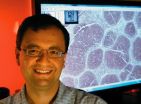(Press-News.org) Researchers are leveraging Ohio Supercomputer Center resources to develop computer-assisted diagnosis tools that will provide pathologists grading Follicular Lymphoma samples with quicker, more consistently accurate diagnoses.
"The advent of digital whole-slide scanners in recent years has spurred a revolution in imaging technology for histopathology," according to Metin N. Gurcan, Ph.D., an associate professor of Biomedical Informatics at The Ohio State University Medical Center. "The large multi-gigapixel images produced by these scanners contain a wealth of information potentially useful for computer-assisted disease diagnosis, grading and prognosis."
Follicular Lymphoma (FL) is one of the most common forms of non-Hodgkin Lymphoma occurring in the United States. FL is a cancer of the human lymph system that usually spreads into the blood, bone marrow and, eventually, internal organs.
A World Health Organization pathological grading system is applied to biopsy samples; doctors usually avoid prescribing severe therapies for lower grades, while they usually recommend radiation and chemotherapy regimens for more aggressive grades.
Accurate grading of the pathological samples generally leads to a promising prognosis, but diagnosis depends solely upon a labor-intensive process that can be affected by human factors such as fatigue, reader variation and bias. Pathologists must visually examine and grade the specimens through high-powered microscopes.
Processing and analysis of such high-resolution images, Gurcan points out, remain non-trivial tasks, not just because of the sheer size of the images, but also due to complexities of underlying factors involving differences in staining, illumination, instrumentation and goals.
To overcome many of these obstacles to automation, Gurcan and medical center colleagues, Dr. Gerard Lozanski and Dr. Arwa Shana'ah, turned to the Ohio Supercomputer Center.
Ashok Krishnamurthy, Ph.D., interim co-executive director of the center, and Siddharth Samsi, a computational science researcher there and an OSU graduate student in Electrical and Computer Engineering, put the power of a supercomputer behind the process.
"Our group has been developing tools for grading of follicular lymphoma with promising results," said Samsi. "We developed a new automated method for detecting lymph follicles using stained tissue by analyzing the morphological and textural features of the images, mimicking the process that a human expert might use to identify follicle regions. Using these results, we developed models to describe tissue histology for classification of FL grades."
Histological grading of FL is based on the number of large malignant cells counted in within tissue samples measuring just 0.159 square millimeters and taken from ten different locations. Based on these findings, FL is assigned to one of three increasing grades of malignancy: Grade I (0-5 cells), Grade II (6-15 cells) and Grade III (more than 15 cells).
"The first step involves identifying potentially malignant regions by combining color and texture features," Samsi explained. "The second step applies an iterative watershed algorithm to separate merged regions and the final step involves eliminating false positives."
The large data sizes and complexity of the algorithms led Gurcan and Samsi to leverage the parallel computing resources of OSC's Glenn Cluster in order to reduce the time required to process the images. They used MATLAB® and the Parallel Computing Toolbox™ to achieve significant speed-ups. Speed is the goal of the National Cancer Institute-FUNDED research project, but accuracy is essential. Gurcan and Samsi compared their computer segmentation results with manual segmentation and found an average similarity score of 87.11 percent.
"This algorithm is the first crucial step in a computer-aided grading system for Follicular Lymphoma," Gurcan said. "By identifying all the follicles in a digitized image, we can use the entire tissue section for grading of the disease, thus providing experts with another tool that can help improve the accuracy and speed of the diagnosis."
INFORMATION:
Computer-assisted diagnosis tools to aid pathologists
Process yields higher throughput; quicker, more-consistent diagnoses
2011-02-01
ELSE PRESS RELEASES FROM THIS DATE:
Explosive- and drug-sniffing dog performance is affected by their handlers' beliefs
2011-02-01
Drug- and explosives-sniffing dog/handler teams' performance is affected by human handlers' beliefs, possibly in response to subtle, unintentional handler cues, a study by researchers at UC Davis has found.
The study, published in the January issue of the journal Animal Cognition, found that detection-dog/handler teams erroneously "alerted," or identified a scent, when there was no scent present more than 200 times — particularly when the handler believed that there was scent present.
"It isn't just about how sensitive a dog's nose is or how well-trained a dog is. There ...
NASA sees large Tropical Cyclone Yasi headed toward Queensland, Australia
2011-02-01
Tropical Storm Anthony made landfall in Queensland, Australia this past weekend, and now the residents are watching a larger, more powerful cyclone headed their way. NASA's Terra satellite captured a visible image of the large Tropical Cyclone Yasi late yesterday as it makes its way west through the Coral Sea toward Queensland.
The Moderate Resolution Imaging Spectroradiometer (MODIS) instrument that flies aboard NASA's Terra satellite captured an image of Cyclone Yasi on Jan. 30 at 23:20 UTC (6:20 p.m. EST/09:20 a.m., Monday, January 31 in Australia/Brisbane local time). ...
Tracking the origins of speedy space particles
2011-02-01
NASA's Time History of Events and Macroscale Interaction during Substorms (THEMIS) spacecraft combined with computer models have helped track the origin of the energetic particles in Earth's magnetic atmosphere that appear during a kind of space weather called a substorm. Understanding the source of such particles and how they are shuttled through Earth's atmosphere is crucial to better understanding the Sun's complex space weather system and thus protect satellites or even humans in space.
The results show that these speedy electrons gain extra energy from changing magnetic ...
UCSB physicists challenge classical world with quantum-mechanical implementation of 'shell game'
2011-02-01
(Santa Barbara, Calif.) –– Inspired by the popular confidence trick known as "shell game," researchers at UC Santa Barbara have demonstrated the ability to hide and shuffle "quantum-mechanical peas" –– microwave single photons –– under and between three microwave resonators, or "quantized shells."
In a paper published in the Jan. 30 issue of the journal Nature Physics, UCSB researchers show the first demonstration of the coherent control of a multi-resonator architecture. This topic has been a holy grail among physicists studying photons at the quantum-mechanical level ...
Children's genetic potentials are subdued by poverty
2011-02-01
Children from poorer families do worse in school, are less likely to graduate from high school, and are less likely to go to college. A new study published in Psychological Science, a journal of the Association for Psychological Science, finds that these differences appear surprisingly early: by the age of 2. It's not a genetic difference. Instead, something about the poorer children's environment is keeping them from realizing their genetic potentials.
Past research has found that a gap between poor children and children from wealthier families opens up early in life, ...
Resolved to quit smoking?
2011-02-01
ANN ARBOR, Mich.--Brain scans showing neural reactions to pro-health messages can predict if you'll keep that resolution to quit smoking more accurately than you yourself can. That's according to a new study forthcoming in Health Psychology, a peer-reviewed journal.
"We targeted smokers who were already taking action to quit," says Emily Falk, the lead author of the study and director of the Communication Neuroscience Laboratory at the U-M Institute for Social Research (ISR) and Department of Communication Studies. "And we found that neural activity can predict behavior ...
Smart lasers could make cancer biopsies painless, help speed new drugs to market
2011-02-01
EAST LANSING, Mich. — Biopsies in the future may be painless and noninvasive, thanks to smart laser technology being developed at Michigan State University.
To test for skin cancer, patients today must endure doctors cutting away a sliver of skin, sending the biopsy to a lab and anxiously awaiting the results. Using laser microscopes that deploy rapid, ultra-short pulses to identify molecules, doctors may soon have the tools to painlessly scan a patient's troublesome mole and review the results on the spot, said Marcos Dantus.
The results touting this new molecule-selective ...
Pakistan floods last summer could have been predicted
2011-02-01
WASHINGTON — Five days before intense monsoonal deluges unleashed vast floods across Pakistan last July, computer models at a European weather-forecasting center were giving clear indications that the downpours were imminent. Now, a new scientific study that retrospectively examines the raw data from these computer models, has confirmed that, if the information had been processed, forecasters could have predicted extremely accurate rainfall totals 8-10 days beforehand.
The study also finds that the floods themselves could have been predicted if this data, which originated ...
Pitt team grows arteries with most elastic protein reported, big step for living vascular grafts
2011-02-01
PITTSBURGH—University of Pittsburgh researchers have grown arteries that exhibit the elasticity of natural blood vessels at the highest levels reported, a development that could overcome a major barrier to creating living-tissue replacements for damaged arteries, the team reports in the Proceedings of the National Academy of Sciences.
The team used smooth muscle cells from adult baboons to produce the first arteries grown outside the body that contain a substantial amount of the pliant protein elastin, which allows vessels to expand and retract in response to blood flow. ...
Plants can adapt genetically to survive harsh environments
2011-02-01
WEST LAFAYETTE, Ind. - A Purdue University scientist has found genetic evidence of how some plants adapt to live in unfavorable conditions, a finding he believes could one day be used to help food crops survive in new or changing environments.
David Salt, a professor of horticulture, noticed several years ago that a variant of the research plant Arabidopsis thaliana that could tolerate higher levels of sodium had come from coastal areas. To test the observation, Salt grew more than 300 Arabidopsis thaliana plants from seeds gathered across Europe. The plants were grown ...
LAST 30 PRESS RELEASES:
People with “binge-watching addiction” are more likely to be lonely
Wild potato follows a path to domestication in the American Southwest
General climate advocacy ad campaign received more public engagement compared to more-tailored ad campaign promoting sustainable fashion
Medical LLMs may show real-world potential in identifying individuals with major depressive disorder using WhatsApp voice note recordings
Early translational study supports the role of high-dose inhaled nitric oxide as a potential antimicrobial therapy
AI can predict preemies’ path, Stanford Medicine-led study shows
A wild potato that changed the story of agriculture in the American Southwest
Cancer’s super-enhancers may set the map for DNA breaks and repair: A key clue to why tumors become aggressive and genetically unstable
Prehistoric tool made from elephant bone is the oldest discovered in Europe
Mineralized dental plaque from the Iron Age provides insight into the diet of the Scythians
Salty facts: takeaways have more salt than labels claim
When scientists build nanoscale architecture to solve textile and pharmaceutical industry challenges
Massive cloud with metallic winds discovered orbiting mystery object
Old diseases return as settlement pushes into the Amazon rainforest
Takeaways are used to reward and console – study
Velocity gradients key to explaining large-scale magnetic field structure
Bird retinas function without oxygen – solving a centuries-old biological mystery
Pregnancy- and abortion-related mortality in the US, 2018-2021
Global burden of violence against transgender and gender-diverse adults
Generative AI use and depressive symptoms among US adults
Antibiotic therapy for uncomplicated acute appendicitis
Childhood ADHD linked to midlife physical health problems
Patients struggle to measure blood pressure at home
A new method to unlock vast lithium stores
Scientists unveil “dissolution barocaloric” cooling, opening new path to zero-carbon refrigeration
Microplastics in the atmosphere: Higher emissions from land areas than from the ocean
Metal clumps in quantum state: Vienna research team breaks records
PolyU develops new human-safe magnetorheological fibres, leading innovations in smart wearable textiles
Rice establishes Global Brain Economy Initiative in Davos, aligned with new report on brain health and AI
Quantum error correction with logical qubits
[Press-News.org] Computer-assisted diagnosis tools to aid pathologistsProcess yields higher throughput; quicker, more-consistent diagnoses



